Psych - Sleep
1/74
There's no tags or description
Looks like no tags are added yet.
Name | Mastery | Learn | Test | Matching | Spaced |
|---|
No study sessions yet.
75 Terms
Consciousness
Consciousness is considered a psychological construct because it cannot be objectively observed or measured through the collection of data, but it is widely understood to exist.
subjective experience
still not fully understand
Normal Waking Consciousness
one broad category of consciousness which is a state associated with being aware of our internal and external environments
everyday activities when awake (normal)
we can manage our attention and behaviour
Altered States of Consciousness (ASC)
An altered state of consciousness is any state that differs in awareness from normal waking consciousness.
levels of awareness are lower or higher than in normal waking consciousness.
two types: naturally occurring and induced
Sleep
Sleep is a naturally occurring and reversible altered state of consciousness, characterised by a reduction in awareness and responsiveness to external surroundings.
unique brain wave activity and other distinguishable physiological changes.
also considered a psychological construct
Sleep as a psychological construct
As sleep is fundamentally private in nature to an individual, we may only infer sleep based on observations and the physiological responses associated with sleep.
What’s the point of the unique changes in sleep
These changes help to differentiate sleep from other altered states of consciousness that might result from brain injury or taking substances.
Types of sleep
REM sleep (rapid eye movement sleep)
NREM sleep (non-rapid eye movement sleep)
Sleep episode details
Eight-hour sleep episode
5 sleep cycles each lasting approx. 90 mins
featuring distinguishable repetitive patterns of REM and NREM sleep
NREM
Non-rapid eye movement (NREM) sleep is a type of sleep characterised by a progressive decline in physiological activity.
NREM sleep consists of three distinct stages and takes up around 80% of a sleep episode in people of school age and older.
NREM Stage 1 (N1)
A transitional phase between wakefulness and sleep. It is considered to be light sleep; physiological responses begin to slow down, including brain activity, heart rate and body temperature.
as sleep episode progresses, a person may not experience more time in N1
if not disturbed for a couple of minutes in N1, will quickly move to NREM Stage 2 (N2)
NREM Stage 2 (N2)
also considered light sleep, during which physiological responses continue to slow down.
A person still wakes relatively easily during N2; however, bursts of brain activity help resist being woken by environmental stimuli such as noises.
N2 is the stage of sleep that is experienced the most throughout a sleep episode.
NREM Stage 3 (N3)
considered to be deep sleep, during which physiological responses are at their slowest and a person is most difficult to wake up.
N3 is known as ‘slow-wave sleep’ due to brain activity being at its slowest.
It is thought that our body is repairing itself during NREM sleep.
During a sleep episode - when is N3 experienced more
During a sleep episode, N3 is experienced more in the first half of the night than the second half of the night.
As a sleep episode progresses, a person experiences less N3 sleep, and may not experience it at all in the last one or two sleep cycles of a typical night.
REM (rapid eye movement sleep)
During rapid eye movement (REM) sleep, your eyes make quick darting movements behind their closed eyelids and your physiological activity increases.
Characteristics of REM Sleep
brain activity resembles wakefulness, and heart rate and breathing rate increase.
Voluntary muscles are seemingly paralysed and twitch only intermittently.
The most vivid and memorable dreams occur during REM sleep.
If you have less sleep than normal, you may experience more REM sleep when you next sleep.
It is thought that our mind is repairing itself during REM sleep.
REM as sleep cycle progresses
A period of REM occurs at the end of each sleep cycle, and these periods get longer and closer together as the sleep episode progresses, which means you have more REM in the second half of sleep than in the first half.
REM and age
REM sleep also differs markedly across different ages, but typically takes up 20% of a sleep episode in people aged around 5 years and older.
Hypnogram
A hypnogram is a line graph of a person’s sleep mapped over time.
displays the patterns of a sleep episode, with a typical night’s sleep for an adult consisting of five sleep cycles featuring REM and NREM sleep.
Time (in terms of the time of a 24-hour day or hours since attempting to sleep) is plotted on the horizontal x-axis. The types and stages of sleep are shown on the vertical y-axis, with wakefulness at the top and deepest sleep at the bottom.
Therefore, a hypnogram shows how a person’s sleep progresses through several sleep cycles consisting of REM sleep and the three stages of NREM sleep, over the course of a night.
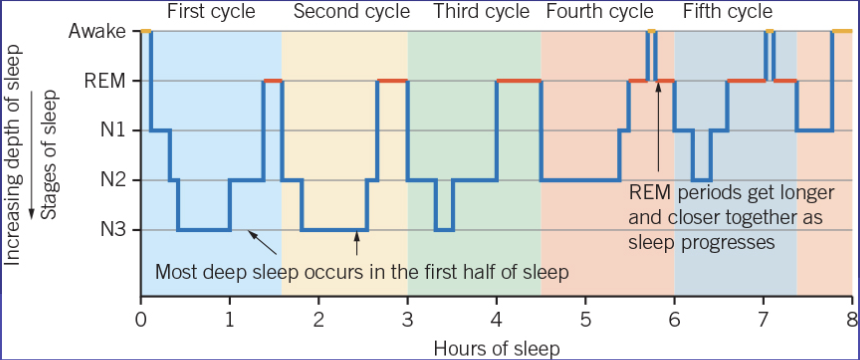
Electroencephalography (EEG)
An EEG detects, amplifies and records electrical activity of the brain (brainwaves)
Non-invasive brain imaging technique that uses scalp electrodes to measure the voltage fluctuations induced by the mass electrical activity of neurons
Brainwaves
Brainwaves are associated with the level of alertness we experience
What is the image a EEG produces
an electroencephalogram
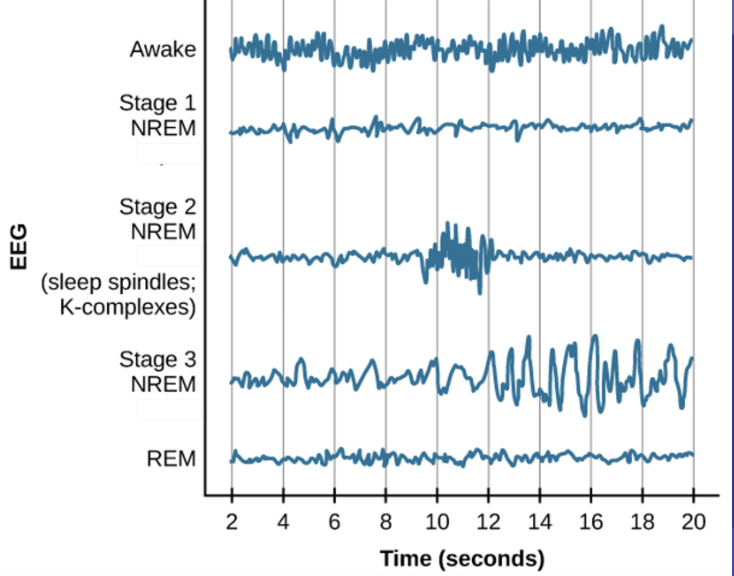
How are the brainwaves measured (EEG)
Brainwaves can be measured in both frequency (the speed - the number of brain waves per second) and amplitude (the strength - the deviation from the central point)
Frequency vs amplitude table
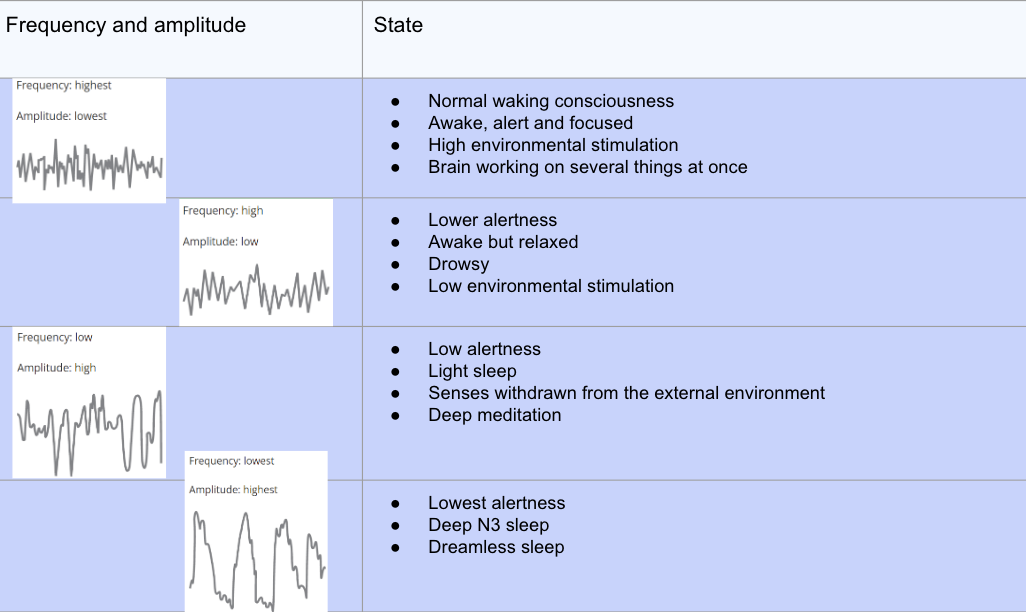
Electromyography (EMG)
Detects, amplifies and records the electrical activity of the skeletal muscles
Can be used on face or body muscles
Additionally, no muscle movement is detected during REM sleep.
Image an EMG produces
an electromyogram
How muscle movement/ tension can be measured (EMG)
Muscle movement/tension can be measured in both frequency (the speed) and amplitude (the strength)
What muscle movement indicates (EMG)
In general, more muscle tension indicates greater alertness, so as a person drifts into deeper sleep, muscle movement decreases.
Electro-oculography (EOG)
This device detects, amplifies and records electrical activity of the muscles that allow the eye to move (it therefore only infers eye movement)
Image EOG produces
an electro-oculogram
How eye-movement can be measured
‘Eye-movement’ can be measured in both frequency (the speed) and amplitude (the strength)
It is measure by placing electrodes around the eye
What do eye-movement measurements indicate
Activity levels of ‘eye-movements’ are associated with different stages of sleep
As you drift into deeper sleep, your eye movement decreases and slows down, and when you experience REM sleep, your eye movement increases.
Subjective measurements of sleep
Sleep diaries
Video monitoring
Measuring consciousness/sleep
Sleep diaries
Sleep diaries are often used when a person is experiencing sleep troubles (e.g sleep apnoea or insomnia) and help sleep experts understand the participant’s experience.
They are a self-reported record of an individual’s sleep & waking time activities.
What kind of records of sleep activity is kept
Time trying to fall asleep
Number, time and length of awakenings during sleep
How sleepy the individual feels at different times of the day
Factors that affect sleep e.g. number of caffeinated or alcoholic drinks consumed
Video monitoring
Video cameras are used to record externally observable physiological responses throughout a sleep episode
Recordings can also be shown to the participant to help them become aware of and understand their behaviour,
eg. showing what they do when sleepwalking or even observing the effects of a snoring partner on their sleep.
Pros of objective data
data is quantitative, which is easy to measure and compare.
minimal interpretations required, thus minimises bias.
more accurate and reliable data, allowing for replication.
Cons of objective data
can lack detail, as no insight gained as to why responses/measurements are obtained.
can be more artificial and lack external validity because measurements are taken in a laboratory.
Subjective data pros
provides qualitative data, thus is more detailed.
can provide insight into mental processes that cannot be directly measured. eg. dreams.
Subjective data cons
qualitative data, means it can be difficult to measure and compare.
requires personal judgements/ interpretation, meaning it is often influenced by bias
it is less valid and reliable due to bias and therefore, more difficult to replicate.
Summary table
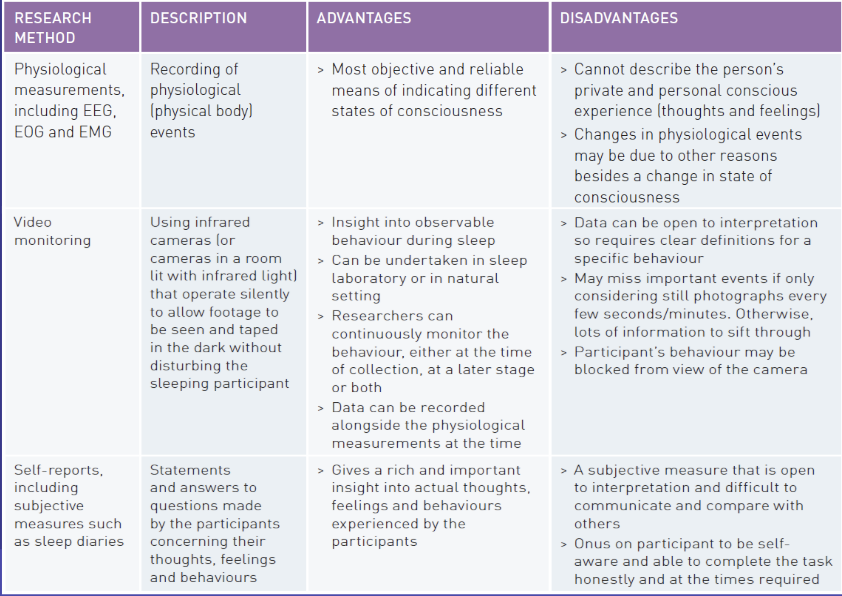
Circadian rhythms
Circadian rhythms are biological processes in all animals that coordinate the timing of activity of body systems over a 24-hour period.
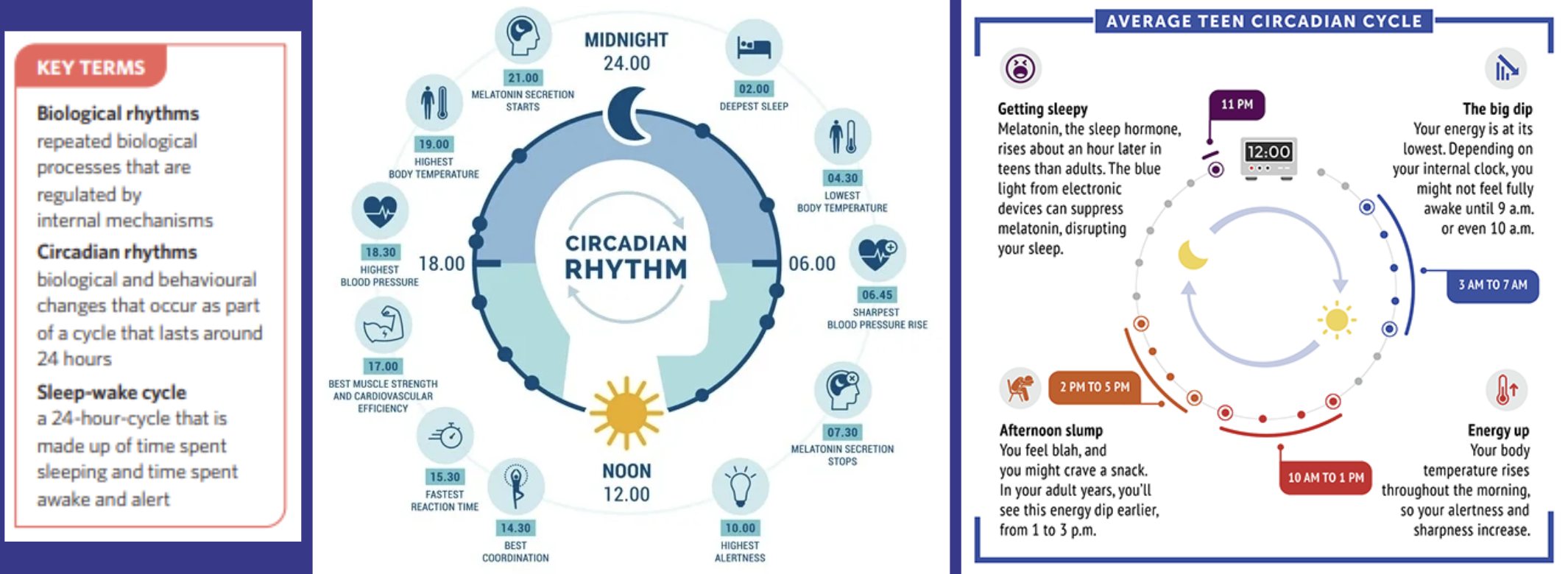
What do circadian rhythms allow us to do?
Circadian rhythms allow for optimised functioning at certain time points over the course of 24 hours.
This is done by controlling our sleep–wake cycle, release of hormones and regulation of body temperature.
Human circadian rhythm period
In humans, circadian rhythms follow a 24-hour period, with most people sleeping at night and being awake and active during the day.
Ultradian Rhythms
Ultradian rhythms are biological processes that coordinate the timing of activity of body systems over periods of less than 24 hours.
Ultradian rhythms may last from a few minutes to a few hours, allowing them to cycle repeatedly over the course of a day.
Examples of ultradian rhythms examples
heart beats, digestion, blood pressure, some hormone secretions and appetite
Sleep in terms of rhythms
Daily cycle of wakefulness and sleep: circadian rhythm, the
sleep portion consists of several sleep cycles occurring as ultradian rhythms.
Within a typical 8-hour sleep episode, a person will experience around five sleep cycles, each lasting around 90 minutes and cycling through a repetitive and reasonably predictable pattern of REM and NREM sleep.
Sleep cycles tend to increase in length over the course of a sleep episode, with a general pattern of increased REM sleep and decreased N3 sleep as we progress through each cycle or ultradian rhythm.

Suprachiasmatic nucleus (SCN)
It synchronises and controls the body’s circadian rhythms - acting as a ‘master body clock’.
The suprachiasmatic nucleus (SCN) is found in the hypothalamus.
How SCN functions
At specific times in a 24-hour day, SCN sends signals to regulate various activities in the body and keep it functioning to a daily schedule of sleep and wakefulness.
The SCN can function independently to maintain an approximately 24-hour cycle because of a precise feedback loop of gene expression and inhibition.
However, it is influenced by external cues known as zeitgebers, such as exercise, social activity, eating patterns and temperature.
The SCN is particularly sensitive to light, and this is why the human circadian rhythm is so closely connected to day and night.
SCN and Light
Light-sensitive neurons in the retinas of the eyes detect incoming light and send messages to the SCN about the amount of light in the surroundings.
More light being received by the eyes indicates daytime
Less light being received by the eyes indicates night-time.
At night-time when the eyes detect low/no light,
The SCN sends an excitatory neural signal to the pineal gland in the human brain.
This results in the pineal gland releasing melatonin, a hormone that induces drowsiness.
The more melatonin released by the pineal gland at night-time induces sleepiness and decreases cell activity. This process ensures that our sleep is connected to night-time.
During the day when the eyes detect more light,
the SCN sends inhibitory messages to the pineal gland, resulting in the inhibition of melatonin release by the pineal gland.
Less melatonin release by the pineal gland increases cell activity in the body.
The result is that a person does not feel drowsy, and therefore wakefulness is promoted during the day.
Explain the SCN and melatonin diagram

SCN and melatonin
The SCN also monitors and is responsive to the levels of melatonin in your blood (an internal stimulus).
When melatonin levels in the blood are high, the SCN signals to the pineal gland to reduce the secretion of melatonin.
THIS IS A NEGATIVE FEEDBACK LOOP
Negative Feedback Loop
A mechanism to stabilise the body’s internal environment by opposing and counteracting the effects of internal or external stimuli.
A regulatory mechanism where the output of a system reduces or slows down the processes that led to that output, ultimately stabilising the system
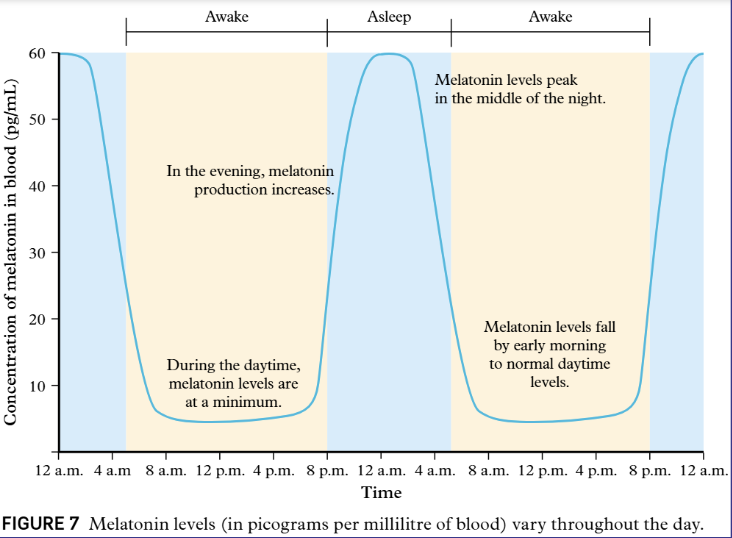
If light cues from sun are absent
the circadian rhythm tends to run free and can cycle for a little longer than 24 hours, resetting on average every 24.25 hours.
Variations in circadian rhythm may explain…
some of the individual differences in those who are a ‘morning lark’ and feel more wakeful in the morning, or those who are a ‘night owl’ and feel more wakeful in the evening.
Scenario: driving at night

Sleep across the lifespan
The need for sleep and the patterns of sleep change as a person ages
also varies among indiv. ppl bc of range of bio, psycho, social reasons
The important things to note abt sleep across the lifespan
The proportion of REM sleep decreases significantly from birth until 2 years old.
The total amount of sleep decreases.
The amount of N3 sleep decreases, replaced mostly by N2 sleep.
A circadian phase delay occurs during adolescence (preference for going to sleep later).
After adolescence, a shift to a circadian phase advance occurs (preference for going to sleep earlier).
Awakenings during sleep increase from adulthood to old age.
Sleep efficiency (the percentage of the time in bed that is spent asleep) reduces.
Circadian rhythm changes
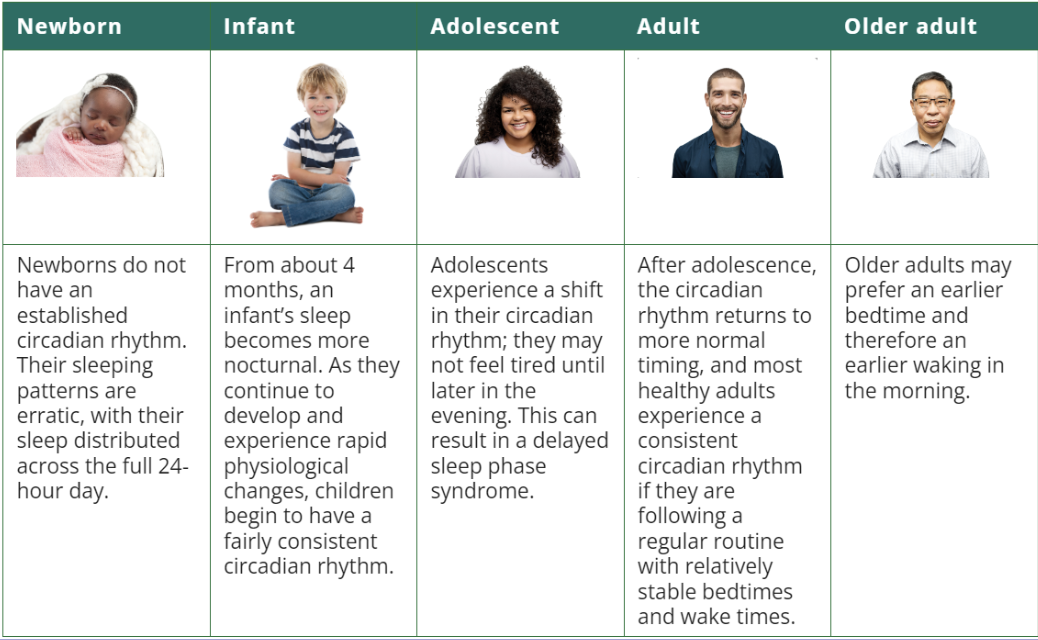
Neonatal period sleep
Age | Total recommended hours of sleep and proportion of REM and NREM | Explanation for sleep patterns |
0-1 month | 14-17 hours Each sleep episode lasts between 2-4 hours REM 50% NREM 50% | Newborns require the highest amount of total sleep for rapid growth and development. highest proportion of REM sleep
|

Infancy sleep
Age | Total recommended hours of sleep and proportion of REM and NREM | Explanation for sleep patterns |
2 - 12 months | 13-15 hours Each sleep episode can last from 5 - 8 hours per night. REM 35-40% NREM 60-65% | Infants begin to sleep for longer periods at a time as their circadian rhythm develops a more regular sleep pattern following day–night cycles. This is due to the SCN and melatonin synchronising with a 24 hour circadian rhythm. |

Childhood sleep
Age | Total recommended hours of sleep and proportion of REM and NREM | Explanation for sleep patterns |
2 -11 years | 9 - 11 hours REM 20% NREM 80% | From the early to late childhood years, the timing of the circadian rhythm gradually delays, and sleep shifts to later in the evening. 2 - 5 years old: N3 makes up more than half of NREM sleep.
|
Adolescence sleep
Age | Total recommended hours of sleep and proportion of REM and NREM | Explanation for sleep patterns |
11 - 18 years | 8 - 11 hours (early adolescence sleep is longer) REM 20% NREM 80% | Adolescents experience a delay in the circadian rhythm because of a hormonally determined shift in melatonin release to 1–2 hours later than other age groups. This can cause a preference for a later bedtime, resulting in fewer hours of sleep than needed because of early waking for school. In this age group, increasing school-related requirements, increasing independence and easy access to constant entertainment and social networks also contribute to delayed bedtime. |
Early to Middle Adulthood sleep
Age | Total recommended hours of sleep and proportion of REM and NREM | Explanation for sleep patterns |
19 - 50 years | 7-9 hours REM 20% NREM 80% | Total daily sleep and proportion of REM is settled for the moment - decreases as we age. N3 continues to decrease and we spend more time in N1 and N2. More frequent awakenings in middle adulthood. Frequent awakenings and lifestyle choices (staying up, work, social pressure, alcohol consumption) leads to decreased quality of sleep. |
Older adult sleep
Age | Total recommended hours of sleep and proportion of REM and NREM | Explanation for sleep patterns |
50 + years | 6 - 7 hours REM 18-20% NREM 80-82% | Sleep patterns in older adults can alter because of lifestyle changes such as retirement, increased health issues including sleep disorders, physical inactivity, decreased social interactions, increased medication use, change of living arrangements and bereavement. A circadian phase advance occurs, and less sleep may be achieved if a person resists the body’s preference for an earlier bedtime and earlier awakening. Amount of N3 sleep continues to decline and may not occur at all, replaced with N2 sleep or more frequent awakenings. During older adulthood there is an increase in sleep latency (the time taken to fall asleep). Melatonin concentrations continue to decline. The shorter total sleep in this stage may be due to the impaired ability to obtain sleep, rather than a reduced need for sleep. |
Sleep pattern summary memorise
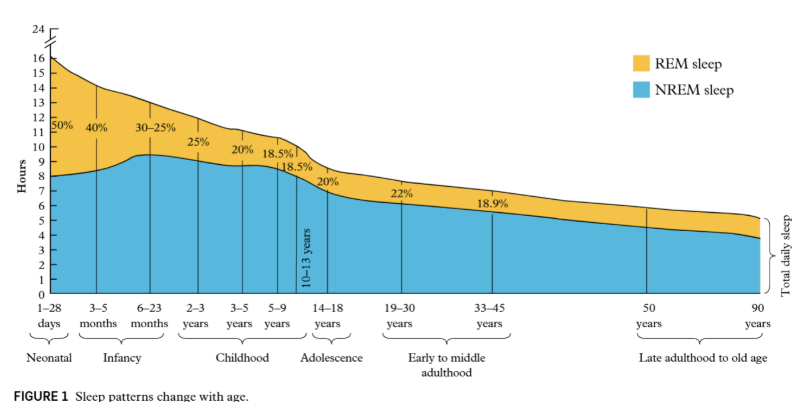
How sleep changes across the lifespan
The amount of sleep decreases as age increases
From children through to old age the amount of time spent awake has increased and total sleep decreases - tends to decrease significantly until adulthood
Proportion of REM to NREM decreases as age increases
REM decreases and then stays relatively consistent from adolescent to adulthood and then decreases again
Sleep onset trends (when we sleep)
Sleep onset (circadian rhythm determined): when you actually fall into sleep
Neonatal (no circadian rhythm, many sleep episodes over 24 hours)
Infants (circadian rhythm becomes established, longer sleep blocks overnight starting ~9-10pm, several naps during day)
*Children (1-2 naps in early childhood, sleep onset gets earlier when naps are dropped 5-7 and shifts later again in late childhood ~7-8pm)
*Adolescents (sleep onset moves later again ~9-10pm (under assumption that you have to sleep earlier than tired to give 8hrs) as circadian rhythm shifts later than both childhood and adulthood by a couple of hours)
Probably around midnight or 1-2am according to circadian rhythm
*Adults (varies but ~8-12am)
*Old age (varies but generally a bit earlier than when an adult)
Sleep onset can be delayed by…
screen use, bright indoor lights, shift work
Sleep latency
between when you get to bed and actually fall into sleep
Trends in sleep awakenings
Neonatal (many over 24 hrs, awake generally not longer than 20-90 min, sleeping pattern is erratic!)
Infants (several short to medium periods awake to feed overnight for ~30-60 min overnight until ~6 months of age, awake periods between naps during the day)
Children (occasional brief to short awake periods overnight)
Adolescents & Adults (stays relatively the same/stable⇒ several brief awakenings overnight)
Old age (many more brief to short awakenings overnight )
Explanation for trends: Melatonin production and age
Neonatal
minimal melatonin production
= no night/day cycle, mostly asleep with regular short period of being awake - SCN not active?
Infants
rapid increase in melatonin
= night/day cycle and establishment of circadian rhythm
Children
melatonin still high = fewer but longer naps, and night sleep
Adolescents
melatonin starts to drop = puberty and night sleep only
circadian rhythm delayed by 1-2 hours
Adulthood
Slow decline in melatonin
Old age
low melatonin production
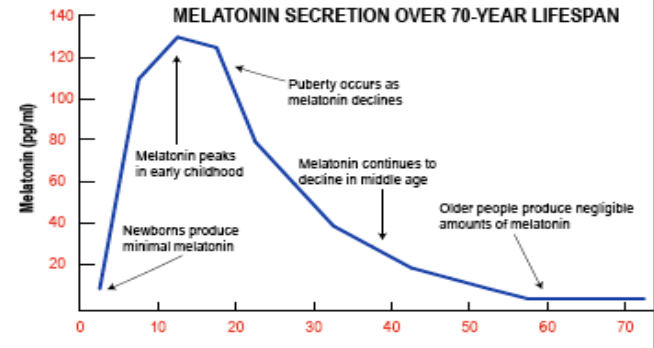
Older people explanation for trends
Older people:
Cortisol levels lower = less blood glucose = less energy -> less active during day & significantly less active at night (maybe also less light entering eyes overall?)
SCN fires less during day and night = fewer messages to pineal gland to produce & release melatonin
less melatonin produced during day and night, and ends earlier in night = less sleepy & less deep sleep, shorter duration sleep
*Still tend to spend the same amount of time or more time in bed compared to adults but less time sleeping effectively